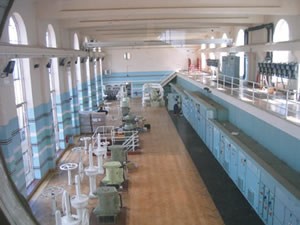IDS ABB project saves Anglian Water £2.7 million on energy costs
 Anglian Water Services (AWS) has saved over £2.7 million on its energy costs following an intensive four year ABB project to improve energy efficiency at over 100 of its sites.
Anglian Water Services (AWS) has saved over £2.7 million on its energy costs following an intensive four year ABB project to improve energy efficiency at over 100 of its sites.
Over the lifetime of the project, AWS saved 223,354 kWh in energy, giving a cost saving of £2.72 million. This equates to 112 tonnes of CO2.
In all, 111 sites were covered with an average spend of £20,000 per site and generating £9,000 of savings.
IDS ABB project saves Anglian Water £2.7 million on energy costs
The project began in 2006 when AWS approached ABB for help in improving the energy efficiency of its sites and reducing its carbon dioxide (CO2) footprint. Using its network of ABB Drives Alliance members (Inverter Drive Systems, Gibbons Drive Systems and Sentridge Control), ABB was able to put together a plan of action to investigate AWS’ use of energy at a number of sites over the company’s extensive operating area and determine how it could make savings.
The ABB Drives Alliance implemented a plan based on its DrivesAdvantage programme, a comprehensive care and support package for users of ABB drives. As well as service and repair, it also ensures that customers are gaining the best possible efficiency from their drives. The initial part of the plan involved training over 90 AWS personnel in programming low voltage AC drives and giving them an appreciation of how drives can be used to save energy. This enabled the AWS engineers to assist in finding energy saving opportunities.
AWS engineers were also trained how to use the flux optimisation feature within the ABB low voltage AC drive, which enabled them to commission a drive correctly for energy optimisation.
David Lockyer of ABB, who managed the overall project, says: “When the drives were originally installed at AWS’ facilities, the emphasis was on getting the process right rather than concentrating on energy savings potential. Consequently, most drives installed have not been saving as much energy as they could. Optimisation is the most cost-effective method of improving efficiency of existing plant. The flux optimisation feature within the ABB drive is a special feature that allows this optimisation to be performed easily.”
ABB Drives Alliance and AWS identified potential drives for optimisation using AWS’ asset databases and ABB sales information. The AWS engineers and ABB Drives Alliance then embarked on a programme to optimise the drives where this had not been done at the original commissioning stage.
Another part of the programme was identifying opportunities to replace existing drives with newer, more efficient versions. Says Lockyer: “As with most technologies, drives have become more efficient over the years, both in terms of their own efficiency and their effect on the power driven system that they operate within.
“By working closely together, the AWS energy team and ABB Drives Alliance were able to identify opportunities to replace existing drives with newer, more efficient versions.”
If necessary, the viability of energy savings can be proven by monitoring the existing system for a period of time, then installing one of ABB Drives Alliance’s hire drive fleet and monitoring again. “This ‘try before you buy’ method helped us to prove to AWS that the proposed upgrade would achieve the savings we predicted,” says Lockyer.
Once a particular project was approved, ABB Drives Alliance decommissioned the old drive and commissioned a new one, disposing of the old drive in accordance with the WEEE Directive.
Another aspect, similar to the new for old approach, was looking for fixed speed applications that could use low voltage AC drives. “These would be applications using some form of throttle or damper to choke the output,” says Lockyer. “For example, an application that used a damper to choke off 60 percent of the output would be an obvious case for a drive.”
Investigating the potential for innovative uses of low voltage AC drives was another strand of the project and the use of drives to control an Archimedes screw to lift water between levels was one of these novel applications.
Another innovative application was the use of ABB’s anti-jam routine used to prevent jamming or ragging of pumps in sewage treatment works. This not only reduces or eliminates the need for regular lifting of pumps to de-rag whilst avoiding pollution spills, but also ensures that pump volutes are kept clean, keeping flows at an optimum level.
Tom Burgoyne is Energy Project Development Engineer for AWS and led the drives engineering project for the company: “We have a framework agreement with ABB and when we wanted to improve our process efficiency with drives, the company was our first port of call.”
“Using drives is a big enabler for us,” says Burgoyne. “Having a drive on a water pump allows us to pick our set points to match demand. We can have both day and night set points and vary them in detail to get the flow we want.
“Another advantage is parallel pumping. Having two pumps working in parallel, we can ramp both down, using less power than using one on its own but giving us the same flow rate or volume.”
An example application was an aeration ditch at the company’s Bassingbourne Sewage Treatment Works. To control the level of dissolved oxygen (DO) in the ditch, a 30 kW ABB standard drive was installed. A minimum speed of around 30 Hz was set on the drive to ensure adequate mixing is maintained within the ditch.
Linked to an existing DO meter, the drive gives a greater range of process control, a reduced risk of mechanical failure and significant energy savings. Power consumption is cut by over 48,000 kWh a year, representing an annual cost saving of over £4,000.
Says Lockyer: “The parameter changes were among the most cost-effective and took only around an hour to achieve and to start making savings. Other savings were more application dependent – if a drive is working at the top of its frequency range then there may not be a lot of scope for savings but as speed reduces, then flux optimisation will kick in and there is more scope for saving energy and therefore costs.”
ABB (www.abb.com) is a leader in power and automation technologies that enable utility and industry customers to improve their performance while lowering environmental impact. The ABB Group of companies operates in around 100 countries and employs about 124,000 people.

